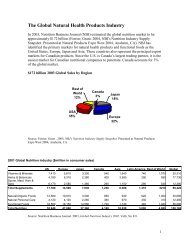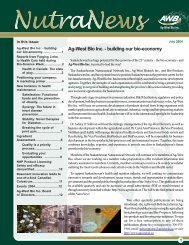Beyond Borders: Global biotechnology report 2010
Beyond Borders: Global biotechnology report 2010
Beyond Borders: Global biotechnology report 2010
You also want an ePaper? Increase the reach of your titles
YUMPU automatically turns print PDFs into web optimized ePapers that Google loves.
In both of these models, investors are also<br />
getting around the “you-can’t-build-it-to-sellit”<br />
problem more effectively than they could<br />
under the traditional funding model. For one,<br />
while they are still looking for an exit via sale,<br />
they aren’t building very much — projectfunding<br />
approaches inherently involve less<br />
infrastructure and overhead. In addition,<br />
since these projects involve very specific<br />
propositions (taking a particular asset to a<br />
defined development threshold in a short<br />
period of time), investors are typically able<br />
to validate at the outset buyers’ interest in<br />
purchasing them if they succeed, and can<br />
even effectively hold the auction “up front”<br />
through the negotiation of a<br />
purchase option.<br />
Other approaches have similarly involved<br />
trying to find ways to fail fast. As has been<br />
widely <strong>report</strong>ed, Lilly’s Chorus experiment<br />
has successfully done this within one large<br />
pharma company by developing a leaner<br />
way to get to clinical proof of concept.<br />
That same approach is now being used<br />
in a wider way through a venture-backed<br />
start-up, Flexion Therapeutics. Flexion,<br />
founded in 2007 by the founding members<br />
of Lilly’s Chorus division with backing from<br />
Versant Ventures, 5AM Ventures, Sofinnova<br />
Partners and Pfizer, in-licenses molecules<br />
from big pharma companies where it thinks<br />
it can quickly and cheaply get them to proof<br />
of concept. (For more details, see “Lean<br />
proof of concept,” by Michael Clayman, on<br />
page 9.)<br />
Big pharma<br />
Big pharma is facing its own new normal,<br />
though this has less to do with the Great<br />
Recession than with longer-term trends<br />
that preceded the economic downturn.<br />
Specifically, the industry’s patent cliff, and<br />
the fact that most firms do not have enough<br />
in their clinical pipelines to replenish the<br />
revenues they are poised to lose, have<br />
driven aggressive restructuring measures<br />
and efforts to access innovation externally.<br />
There are differences of opinion on the need<br />
for diversification — some companies are<br />
remaining focused on the core business of<br />
drug innovation, while others are expanding<br />
into a variety of other businesses, from<br />
branded generics to nutraceuticals.<br />
Despite these differences, the industry<br />
has consistently been shifting from a<br />
blockbuster-based model toward one based<br />
on products targeted at smaller patient<br />
populations. These changes, sometimes<br />
referred to as the transition from Pharma<br />
1.0 (“the blockbuster model”) to Pharma<br />
2.0, have been discussed extensively,<br />
including in prior editions of <strong>Beyond</strong><br />
borders and in our sister publication on the<br />
pharmaceutical industry, Progressions. For<br />
several years, the biotech industry benefited<br />
from big pharma’s pipeline challenges, as<br />
large companies bid up prices for desirable<br />
platforms and late-stage pipeline assets.<br />
While pharma’s patent cliff has been<br />
anticipated for some time now, the<br />
pressures are becoming particularly acute<br />
just as biotech and pharma companies<br />
are grappling with the new normal. For<br />
several pharma companies, the biggest<br />
blockbusters are scheduled to go off-patent<br />
in 2011 and 2012, at which point the<br />
industry will finally be on the other side<br />
of the cliff, leaving a number of firms with<br />
reduced revenues and cash flows with which<br />
to buy their way out of trouble.<br />
Pharma’s challenges are also being<br />
compounded by the transition to the next<br />
phase of the industry — something we<br />
term “Pharma 3.0” in the <strong>2010</strong> edition<br />
of Progressions. The convergence of<br />
new trends such as health care reform<br />
and the adoption of health information<br />
technology (IT) promises to change the<br />
very business that drug companies are in,<br />
8 <strong>Beyond</strong> borders <strong>Global</strong> <strong>biotechnology</strong> <strong>report</strong> <strong>2010</strong><br />
from selling drugs to delivering outcomes.<br />
As pharma companies desire new solutions<br />
to deliver health outcomes — as well as<br />
to address Pharma 2.0 challenges such<br />
as serving patients in emerging markets<br />
— many “non-traditional” companies<br />
are sensing opportunities to capitalize<br />
on increased health spending and are<br />
entering the fray. Pharma companies<br />
are beginning to collaborate with these<br />
entrants — from sectors as disparate as<br />
IT, telecommunications, retail trade and<br />
financial services — to create entirely new<br />
service and product offerings customized<br />
for the world of Pharma 3.0. We’ve seen a<br />
flurry of partnerships in recent months, and<br />
while these have mostly been early-stage<br />
experiments and pilot programs, partnering<br />
with non-traditional entrants will likely<br />
become a greater focus over time.<br />
Pharma companies have long been<br />
vital partners for the <strong>biotechnology</strong><br />
industry — providing everything from<br />
clinical expertise to R&D funding and from<br />
validation of early-stage assets to exits<br />
for investors and founders. It is almost<br />
inevitable, therefore, that the sweeping<br />
changes under way in the pharma industry<br />
will have significant repercussions for<br />
biotech companies and their investors.<br />
For instance, there has been a marked<br />
uptick over the last couple of years in<br />
the number of deals that are structured<br />
to include options. In these transactions,<br />
buyers do not purchase or in-license an<br />
asset but rather pay for the right to license<br />
it at a later date (e.g., when a clinical trial<br />
has been successfully completed). To some<br />
extent, these deal structures, which typically<br />
allow buyers to take on less product<br />
development risk, have been enabled by<br />
the fact that many biotechs have seen their<br />
bargaining power diminish in today’s capitalconstrained<br />
environment. But option-based<br />
transactions are also being<br />
continued on page 10








